GDE 710
WEEK 8
Skills & making
This week begins with an inquiry into our skills, those skills that we have and are our strengths and those skills we lack or are not very good at. We looked into our process, and how we go about making things. The main questions driving the week were:
What would you like to be doing that you are not doing in your work?
How important are side projects and are you currently working on any?
Whis skills do you have? What skills do you need?
Finding the Gaps

Do nothing, and your mind will immediately come up with 50 really very attractive, interesting, juicy ideas... and from that space of not doing it, it becomes crystal clear about what I’m doing next.
Sam Winston
What would you like to be doing that you are not doing in your work?
My overall takeaway from the first lecture was that all the designers were happy doing what they were doing and didn't for the most part want to be doing anything else. Infact for some if they weren't doing what they are doing they don't know if they would be able to do anything else. Simon Manchipp's agency life keeps him so busy and offers him so much variety that as a designer it keeps him stimulated and doesn't seem to leave space for wanting to do anything else. Sam Winston's work as I've come to know through previous lectures as well is born out of what was technically his side work. He is an artist of sorts and his work is so tied to his identity that when confronted with doing something else he will choose to retire off into the woods and just not do anything. It was interesting to hear what Regular Practice designers had to say, in the sense that they always end up doing what they want to no matter the client brief because they collect the things they want to explore and then fit them in when a problem presents itself.

Sarah Boris seemed to be the only designer who wanted to explore stuff outside of her work with print and pixels, wanting to venture into homeware, tableware and products. I could relate to that as there are things I want to do as side projects that are textile and product related and not just limited to graphic design. Intro designers seemed to be in both camps. It felt like for the most part they enjoy the work they get to do with clients, and side projects seem lucrative as a welcome relief when they are not enjoying client work and fall into complaining about clients and their everyday work. It was a good insight into the fact that side projects offer designers fulfllment and their own expression without the confines of another person.
How important are side projects and are you currently working on any?
In the second lecture Simon confirms what I felt about his work in the agency keeping him so busy that he doesn't have or do side projects. Its interesting that he uses the words 'busy' and 'hustle' to refer to his work. Since those were the very words that came to my mind when describing him. What I found interesting was that his idea of side projects drew from his life before the agency setting and how he saw them then as doing projects for people as a way of making some money on the side or helping others out. And how now a side hustle for him—in the agency setting—is this idea of his agency producing their own products apart from the design services. I often think of and have lists of ideas that I want to do and interestingly enough they are mostly products I'd like to make and sell. He mentions it is hard to make products and how he gets to see the client's side. That I would think is accurate from my point of view as well. These side products of mine I'd like to create often don't get finished or out the door because I lack the skills or the patience to produce and complete them.
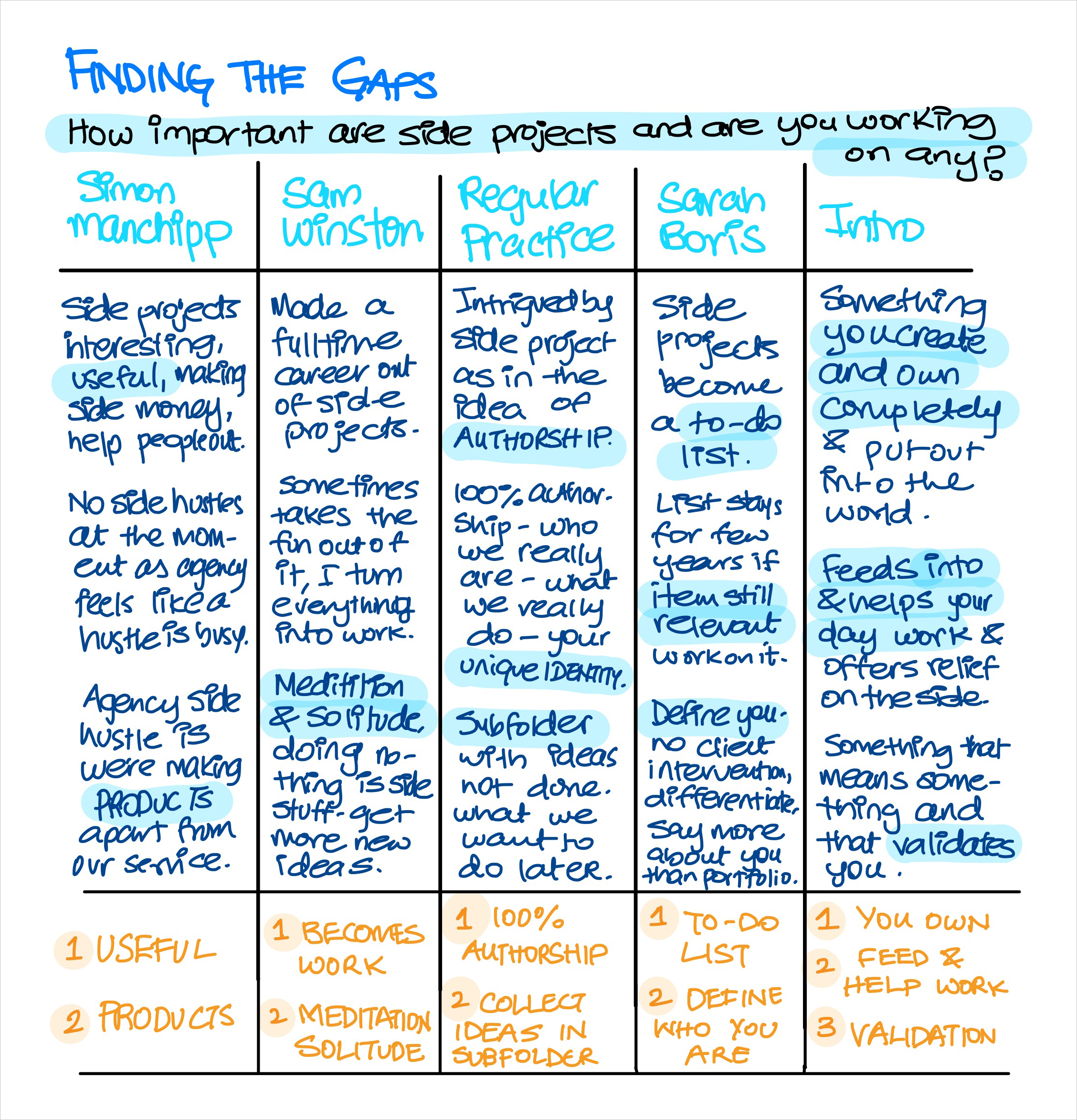
Four other themes that stood out for me were the idea of authorship as mentioned by Regular Practice and echoed in different words like ownership by Intro and the idea of side projects defining you by Sarah Boris. The second theme that showed up was this idea of side projects influencing, feeding into or becoming all or a part of your main work—Sam Winston and Intro talked about this. Another idea was about side stuff we do providing relief (Intro). I could relate to this, as I often have turned to creating stuff on the side when I need relief from normal everyday work projects. Sam Winston went further and talked about solitude and meditation in itself being something he does on the side and which helps him with ideation, this idea of surrender and trust being the breeding ground for new ideas to emerge. The fourth theme that I've found myself preacticing as well that Sarah and Regular Practice both referenced was this notion of a to-do list or a subfolder with collections of ideas along the way which may sit there and either be used in a project at a later date or developed years later if still relevant and important to the designer.
To conclude my reflection, I would like to talk about the quote I prefaced at the beginning by Sam Winston. It serves as a reminder to myself and is my main takeaway this week. Sam's words really stood out to me. This idea of doing nothing and trusting something will come, and you will be clear of where to go next. I think in our noisy, fast-driven and hustle-culture world today, we feel guilty if we are 'doing nothing' and that anxiety of 'doing nothing' stops us and we become busy in doing 'something' or worse trying out 'everything'. Whenever I've gotten my best ideas its because I stopped or things overwhelmed me so much I had to stop and do nothing and it was after that period of 'rest' that ideas 'arrived'. I trust that process, even if we all can't quite explian it, and sometimes in the hustle of work I can tend to forget about it. It's something I want to try to do more intentionally and I like how Sam has it as a ritual as part of his process to consciously do nothing. Thanks Sam for spelling it out for me!
Workshop Challenge
CHALLENGE: What are your skills? What are the gaps? Write a list of your current skills and a separate list outlining the skills that you want to acquire. This can include ways of working, thinking or an area of knowledge you wish to develop. Create a ‘process model’ which summarizes the skills you currently possess and the gaps you wish to fill. This piece of work could be a diagram, a 3D statement that clearly communicates a thought process relevant to you at this moment (how you deal with weaker skill gaps and how you maximize your talents), a statement, a model, a tool.
I started off the challenge by making a list of my skills and gaps:
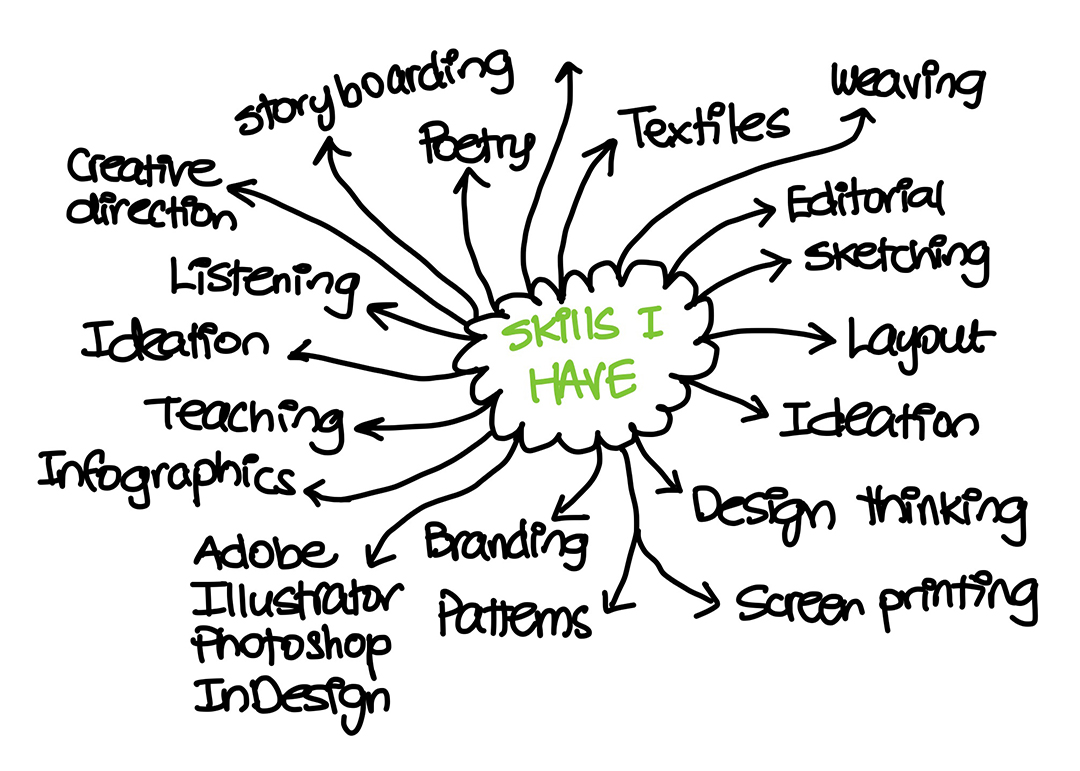
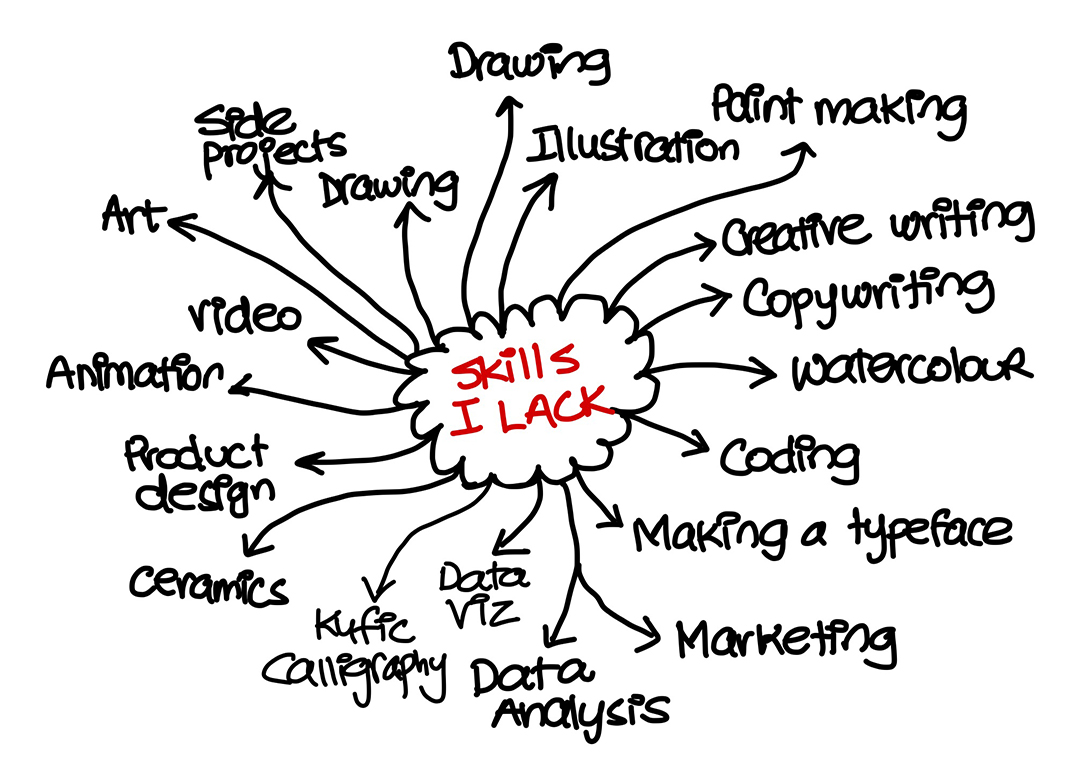
I went down a bit of a rabbit hole here thinking up elaborate toolkits for ideation as concepts, completely not thinking about the process, how it occurs for me or even how my skills and gaps show up. I think I really got excited by something I've wanted to explore as a side hustle and at the same time have not made time for. I think I was also confronted by the idea of not liking that I had these gaps. At this point I remembered the School of Life video from our resources and how it talked about getting real, authentic and vulnerable with ourselves. So I stopped and started thinking about my process and what happens when I am inside the process. How and what thoughts come up. How it feels when I am in those places of questioning and when I am blank and doubting myself. I questioned why those moments show up and what it is that prompts them. I uncovered that whenever I take on a brief and if I have an idea but am struggling with its execution whether it be lack of skill or lack of confidence these blocks show up and shut me down. At such moments I am anxious and I don't trust a solution will come and fear of failure sets in. Those creative blocks are not fun at all.
Taking impetus from all of this I sat down and began typing out all the thoughts that go through my head. Mapping out the ups and downs and thought-rollercoaster if you will.
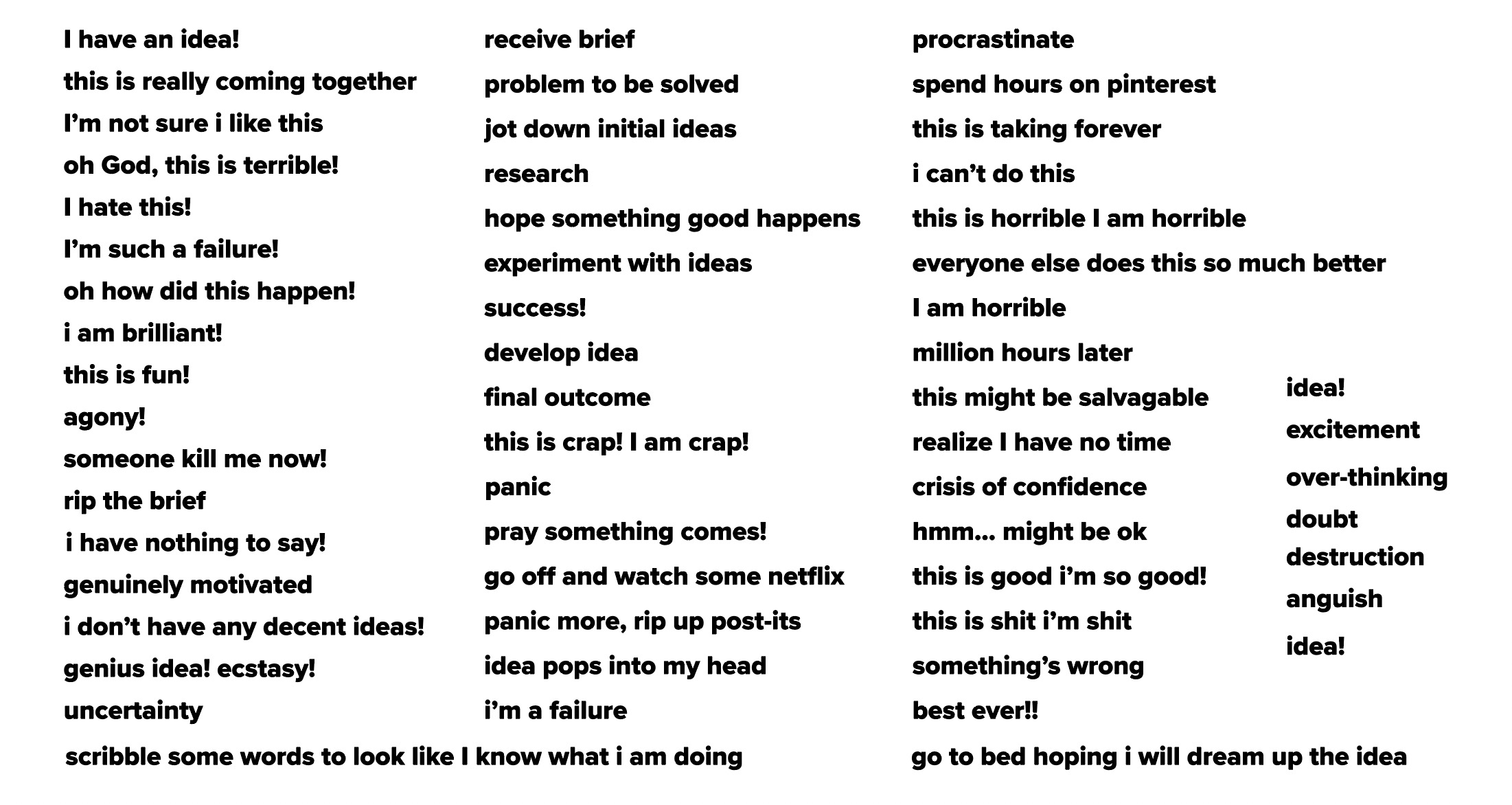
From here I chose to use EMOJIS to illustrate the various parts of the process as there wasn't enough time to illustrate anything myself. I chose Jessica Walsh's side project of designer emojis that she designed for designers at the start of the pandemic. For my process, I used colours green, orange and red to give a sense of the 'temperature' of the emotion being exprienced. The green obviously reflected things I am good at and know how to do—the skills—the red represented the gaps and the areas which invoked anxiety and lack of confidence and prompted creative blocks. In a snakes and ladders type of sentimentality the process diagram took form and conveyed my emotional journey during my creative process. Here is my final outcome:

After I was done with this, I decided to also flush out the initial idea I had of a tool to help with ideation. To provide a random divergent trigger to get oneself out of a creative block by prompting to think and tackle the problem with an 'oblique strategy'. I was clearly having way too much fun this week. So I developed out my idea for a creative-block buster dice. Due to time constraints I didn't make this with my hands as planned and rather decided to mock it up in Adobe Dimension. Here is this off-shoot outcome:
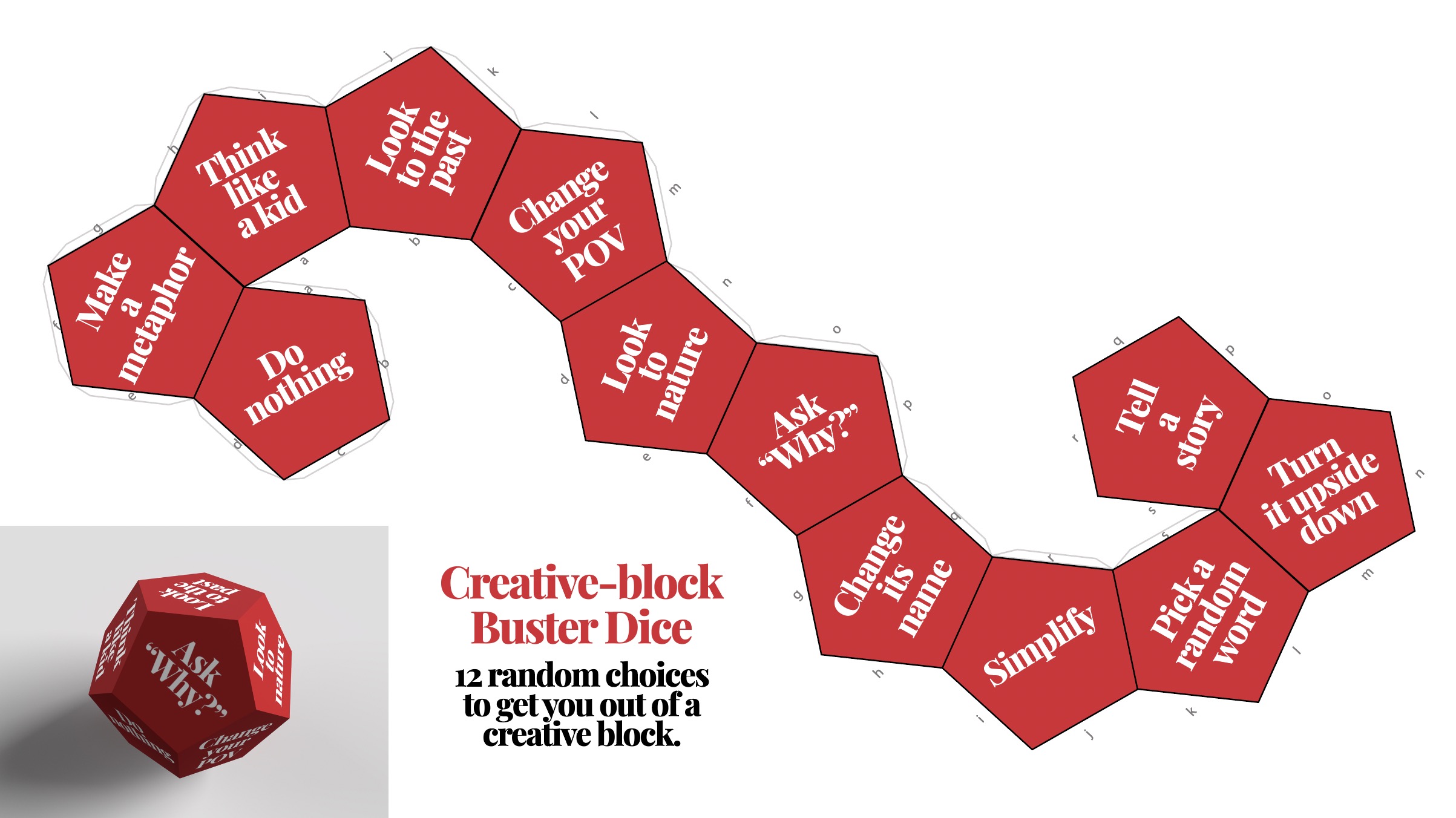
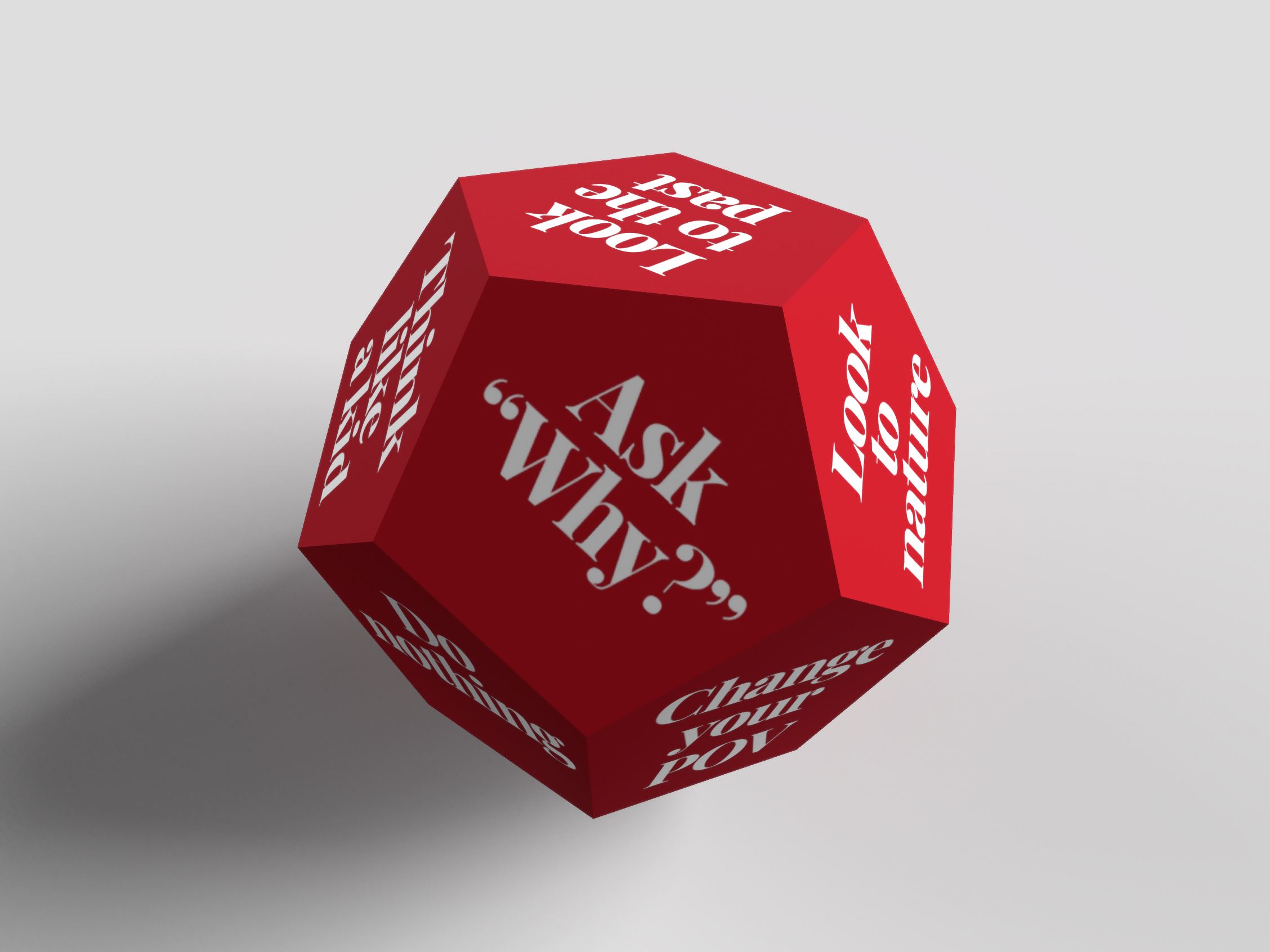
Final thoughts and reflection
Oh wow, this week was a bit of a mental rollercoaster. It really had me confront the gaps, my strengths, my weaknesses. It also had me get real about how I operate when I don’t want to fail. I’ve decided I’m going to make it a practice to do side projects, do something for my creative expression, as opposed to just client-side work. I have so many ideas, so many items on my list I’d like to explore but not trusting I can do them or have the skills to stops me.
I think pushing myself this week and being courageous showed me I can just try things out without knowing how to do everything. I think my experiment with Adobe Dimension was quiet fruitful and made me learn it’s ok to just mess around with stuff without having to spend hours learning first, and that I don’t have to be an expert in something before I attempt it. Yay!
Thank you for taking the time to read this.
© Nida Khan, 2020 — All rights reserved.
Contemporary Practice
Week 1 • Introduction
Week 2 • Industry Today
Week 3 • Fields of Practice
Week 4 • The Self and Identity
Week 5 • Thoughts on Ideas
Week 6 • Noticing the Ignored
Week 7 • Research and Theory
Week 8 • Skills and Making
Week 9 • Message Delivered
Week 10 • Type and Page
Week 11 • Trends and Environments
Week 12 • New Steps
History & Futures
Coming soon...
Studio & Entrepreneurship
Coming soon...
Application & Interaction
Coming soon...